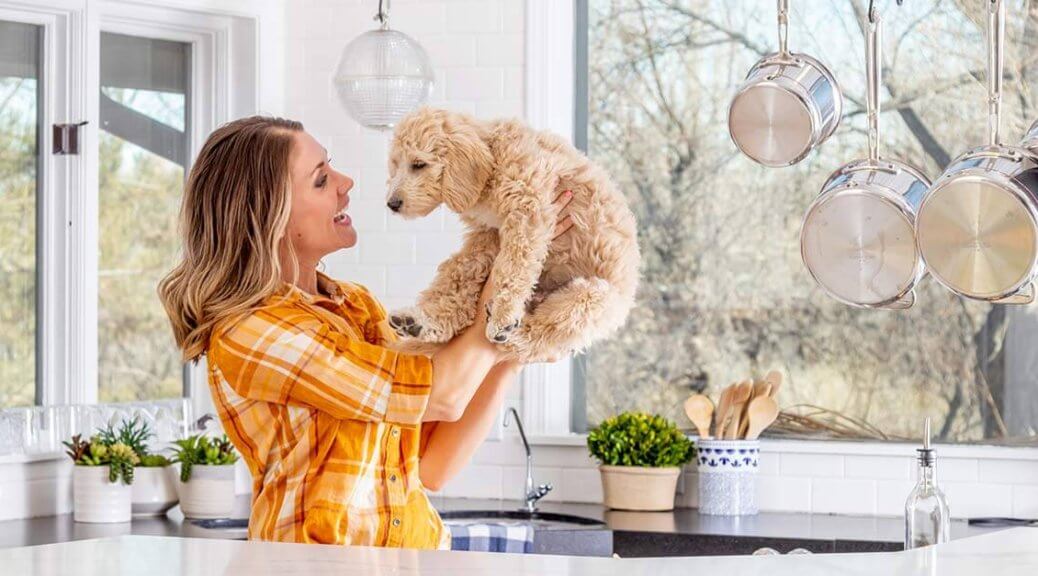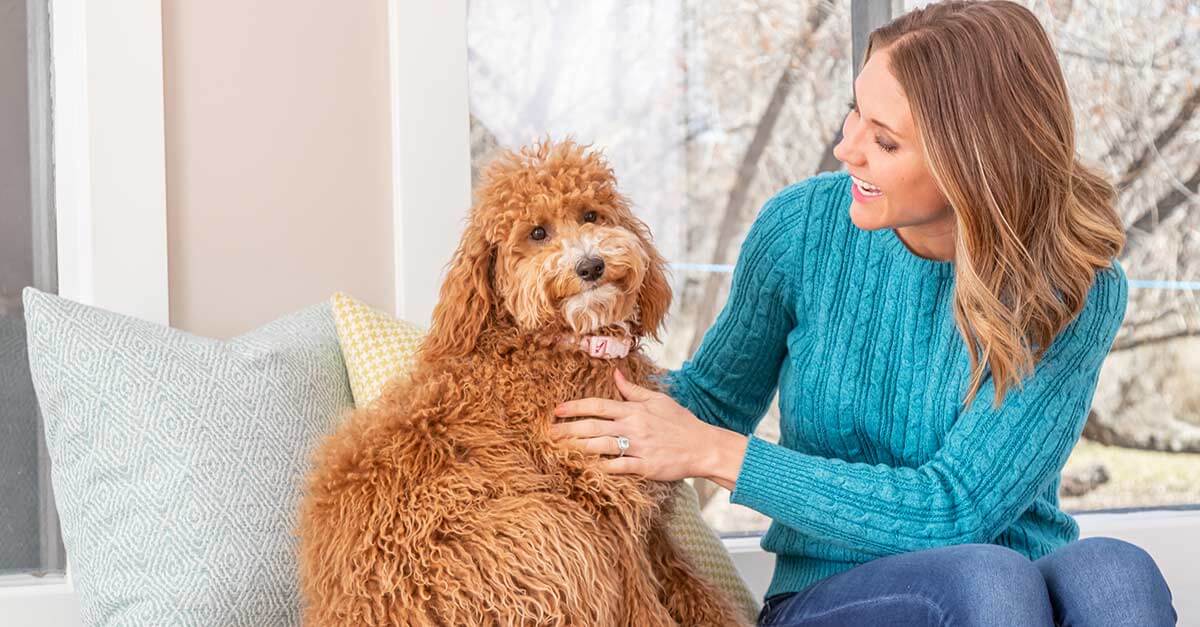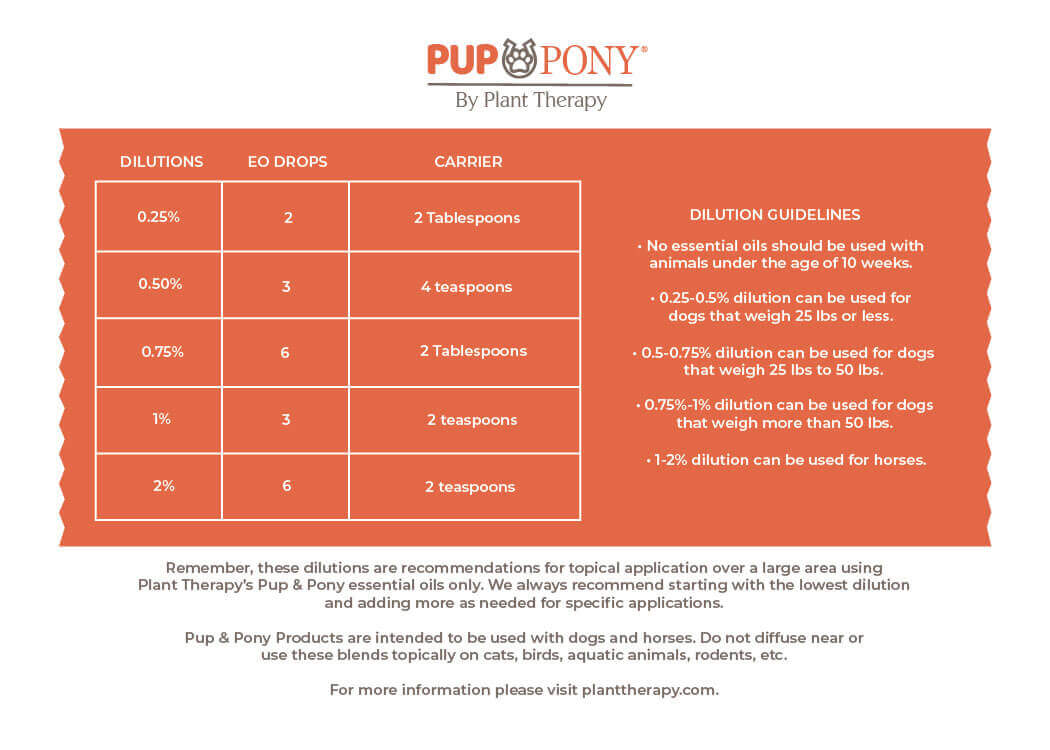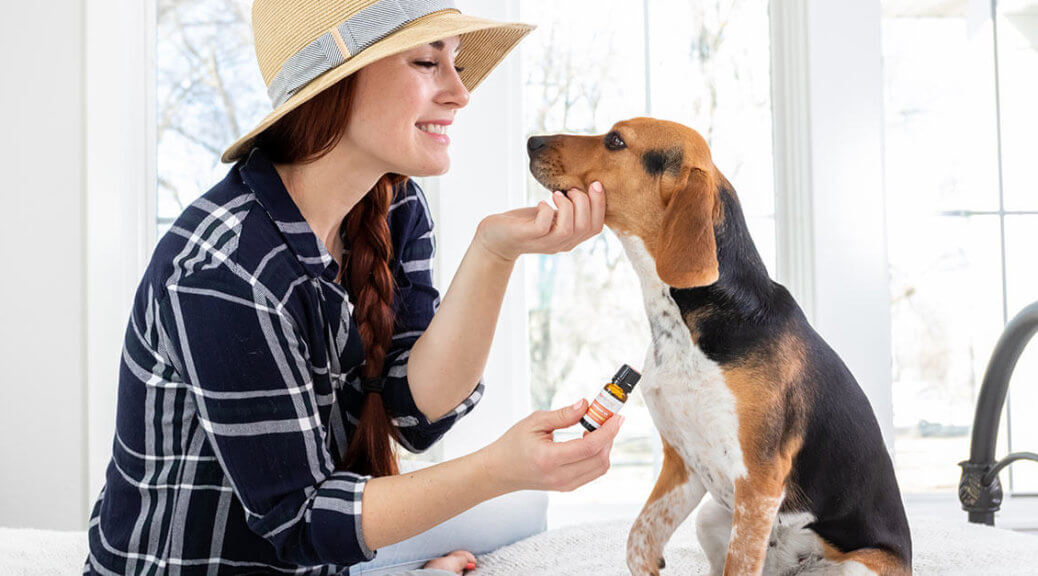When you love your fur baby like family, you’ll always want the best for him or her. Dogs become our best friends, devoted protectors, playmates, motivators, and so much more. And like us, dogs can suffer from emotional and physical ailments that can seriously interfere with their quality of life. Because of this, many people are wondering about the effective and safe use of essential oils and dogs. They help us humans out so much; could they help dogs, too? They sure can!
How can EOs help our beloved doggy pals?

First, it is critical to understand what an essential oil and how powerful these highly concentrated and volatile compounds are. Please head over to this wonderful video series if you need to learn about these plant substances and how they can affect just about every system of the human body.
Since humans and dogs obviously have very different bodies, we do not react to essential oils in the same way. This is super important to consider before you use your EOs for, or even near, your dog. Just because you can handle a certain EO and really enjoy it, doesn’t mean your dog will. Actually, some oils can be very dangerous to dogs, especially when not diluted properly. But we’ll get into that shortly.
What is good to know is that when used correctly, essential oils can help address a variety of health concerns for your dog, including skin issues and emotional struggles, like anxiety.
Now let’s learn about doggy anatomy!
It’s common knowledge that dogs have a much better sense of smell than humans. But sometimes, that’s really difficult to translate into how that affects their day-to-day behaviors, desires, and needs. Please take about four minutes to check out this amazing video by TEDEd, which gives a perfect breakdown on the power of a dog’s sense of smell. This information alone may get you thinking about how you use your essential oils and how it may be affecting your dog—even if that isn’t your intention.
So where do we begin?

If you’re interested in supporting your dog with aromatherapy, you might be wondering how to start. Oftentimes, when introducing essential oils to a human friend, you’ll just pass them the bottle and have them take a whiff. But that is definitely not the correct approach to introducing an oil to a dog. Inhaling straight from the bottle will be too overwhelming due to their sophisticated olfactory system and can cause both physical and emotional distress. Instead, we want to focus on first creating a positive association with the scent of the essential oil or EO blend you have in mind.
To do this, let’s run through a hypothetical situation.
Say your pooch is suffering from some general nervousness and you would like a natural way to help calm them down. You may simply choose the tried and true EO for calming, Lavender, which is also a safe choice for dogs. First, you’ll dilute the Lavender to the recommended amount based on your dog’s weight (we will go over this a little further down). Then rub that on your palms and present your palms to your dog. Do not force your palms on him or her, just simply present them to your dog and see if he or she is interested and see what the reaction is. If your dog responds well to the scent, continue doing this for a few days. That way, they will begin to associate that lovely Lavender aroma with their most favorite person—you!
Increase this positive association by including the aroma into activities your dog enjoys doing, like going for a walk, playing fetch, cuddling on the couch, or anything else! Once your buddy has given his or her A-OK to the essential oil, you can move on to applying it topically or using it aromatically.
Some signs of acceptance include your dog showing an interest in the oil, a willingness to continue inhalation of the oil, visible relaxation, and licking the oil. While we would never recommend allowing your dog to intentionally ingest essential oils, the very diluted amount on your palms will not cause harm if licked a bit.
Some signs of an aversion to an oil include walking away from the aroma, an aggressive emotional response, pacing, panting, turning head away, whining or whimpering, or showing respiratory distress.
If you’re interested in supporting your dog with aromatherapy, you might be wondering how to start. Oftentimes, when introducing essential oils to a human friend, you’ll just pass them the bottle and have them take a whiff. But that is definitely not the correct approach to introducing an oil to a dog. Inhaling straight from the bottle will be too overwhelming due to their sophisticated olfactory system and can cause both physical and emotional distress. Instead, we want to focus on first creating a positive association with the scent of the essential oil or EO blend you have in mind.
To do this, let’s run through a hypothetical situation.
Say your pooch is suffering from some general nervousness and you would like a natural way to help calm them down. You may simply choose the tried and true EO for calming, Lavender, which is also a safe choice for dogs. First, you’ll dilute the Lavender to the recommended amount based on your dog’s weight (we will go over this a little further down). Then rub that on your palms and present your palms to your dog. Do not force your palms on him or her, just simply present them to your dog and see if he or she is interested and see what the reaction is. If your dog responds well to the scent, continue doing this for a few days. That way, they will begin to associate that lovely Lavender aroma with their most favorite person—you!
Increase this positive association by including the aroma into activities your dog enjoys doing, like going for a walk, playing fetch, cuddling on the couch, or anything else! Once your buddy has given his or her A-OK to the essential oil, you can move on to applying it topically or using it aromatically.
Some signs of acceptance include your dog showing an interest in the oil, a willingness to continue inhalation of the oil, visible relaxation, and licking the oil. While we would never recommend allowing your dog to intentionally ingest essential oils, the very diluted amount on your palms will not cause harm if licked a bit.
Some signs of an aversion to an oil include walking away from the aroma, an aggressive emotional response, pacing, panting, turning head away, whining or whimpering, or showing respiratory distress.

All dogs are different and these lists are not all-inclusive. Basically, you are looking for out-of-the-ordinary behaviors from your dog to help determine if he or she is accepting or rejecting the essential oil.
DOs & DON’Ts
- DO start slowly and watch for a reaction.
- DON’T present undiluted essential oils to your dog.
- DO apply the oil to yourself for the first few days before applying to your dog.
- DON’T force essential oils on your dog if they show aversion. This may lead to a negative emotional reaction.
- DO be familiar with your pet’s current health issues and speak with a veterinarian to help decide if using EOs is the right choice.
- DON’T add essential oils to your dog’s food or water.
- DO start with the lowest recommended dilution.
- DON’T use on puppies under 10 weeks old.
Once a positive scent connection has been established, you can start diffusing and using topically!
How to diffuse for your furry friend.
When actively diffusing, we recommend using an ultrasonic type of diffuser (like the NovaFuse, UltraFuse, & AromaFuse). Use 1-2 drops per 100 mL of water and begin diffusing for 5 to 10 minutes every few hours. This allows you to determine how your dog will react to the aroma permeating the air. Remember, your dog is so much more sensitive to scents than you are and a little bit goes a long way!
We recommend that you diffuse in a well-ventilated area that your dog is able to leave if he or she wants to. Avoid continuous diffusion and do not place diffusers directly on a dog’s crate if they are locked inside. If you notice any kind of negative reaction, immediately discontinue use and lead your dog to some nice, fresh air.
If you’d like to try passive diffusion techniques, your dog may enjoy the Paw Pal Diffuser. Adding a drop of an accepted essential oil or blend on a cotton ball and tucking that under the cover of your dog’s bed may also be well tolerated. Please note that when using passive diffusion we recommend diluting the EO as if you were applying topically. Do not use undiluted essential oils near your dog.
How to use EOs topically on your dog.
To help support issues such as skin conditions and tummy troubles, topical application may be very helpful! Apply the accepted essential oil or blend to the areas suggested below related to the area of concern. Ideally, apply the diluted blend while doing an activity your dog enjoys. Each dog is different, but a few suggestions include applying it during massage applications, while cuddling, or even when giving them their favorite treat. Positive reinforcement is critical to the success of using EOs with dogs. Never apply directly to the mouth, whiskers, nose, nostrils, ears, eyes, or sensitive genital areas.
Plant Therapy’s Dilution Guidelines for dogs:
- 25 lbs or less: 0.25-0.5%
- 25 lbs to 50 lbs: 0.5-0.75%
- 50 lbs and more: 0.75-1%

Areas of application:
- Back of neck
- Chest
- Upper inner foreleg (doggy armpit!)
- Abdomen
Doggy-Safe Essential Oils:
We recommend our Pup & Pony Blends, which include only safe essential oils. These were carefully formulated with your pup in mind and cover a wide variety of both physical and emotional issues.
Safe single oils include Cedarwood (all varieties), Chamomile (all varieties), Eucalyptus Globulus & Radiata, Frankincense (all varieties), Lavender, Mandarin, Palmarosa, Sweet Orange, Sandalwood (all varieties), and Vetiver.
Essential oils to avoid include Anise, Blue Tansy, Camphor, Clove, Garlic, Oregano, Tea Tree, Wintergreen, and Yarrow.
Introducing: Pup & Pony

Plant Therapy’s Pup & Pony line was created to provide a safe, natural, and effective method for supporting our beloved four-legged friends on their journey to emotional and physical well-being. We understand and have fully experienced the therapeutic properties of essential oils with humans and now, after undergoing extensive research, we are excited to extend the same benefits to our animal companions in a safe and efficacious manner.
Take a look at our dog (and horse!) friendly blends:
Confident K9: Confident K9 was formulated for dogs who struggle with being alone. It helps promote relaxation, support doggy confidence, and soothe worry. Whether it’s excessive barking or shaking to chewing on belongings or clawing at your front door, Confident K9 can help! While Confident K9 was created specifically with dogs in mind, it is also safe and effective for horses who may struggle with similar issues.
Happy Trails: Happy Trails was created to make traveling easier for your dogs and horses. Our four-legged friends can experience motion sickness during travel just like humans. This blend’s scent is soothing to your animal’s upset stomach, and also works to comfort your animals so they stay calm and worry-free.
Horse Whisperer: Just like humans, dogs and horses can develop fear and anxiety disorders after a traumatic experience. Trauma is especially common in rescue animals but also occurs during events we may not normally consider, such as forced weaning, continuous use of ill-fitting tack, etc. This blend helps to calm and comfort animals while supporting their emotional healing process. While Horse Whisperer was created specifically with horses in mind, it is also safe and effective for dogs who may struggle with similar issues.
Show Ready: Show Ready was created to keep your dogs and horses healthy. Dogs and horses become more susceptible to illness and disease during times of travel, stress, when being boarded for long periods of time, or when exposed to other ill or unfamiliar animals. This blend utilizes essential oils that will help to support the immune system and offer protection from illness.
Final thoughts to keep in mind…

Confusing the word “natural” with “safe” can be a dangerous assumption. Yes, essential oils are wonderful, natural products that can support humans and dogs in all kinds of ways, but they must be used responsibly. They can pose serious health risks for dogs if used without care. Since the chemicals that make up essential oils are metabolized through the liver, we recommend that your dog be more than 10 weeks old and of generally good health before introducing essential oils. Please talk with a veterinarian immediately if you suspect any health concerns after using essential oils.
Want to learn more about Pup & Pony? Well, you’re in luck! In this Plant Therapy Live video, recorded on April 12, 2019, Emilee Hughes (Certified Aromatherapist and the brains & beauty behind this new line!) and Retha Nesmith (Certified Aromatherapist and VP of Customer Experience) talk all about the blends, Paw Balm, and Paw Pal Diffuser, plus all kinds of customer questions! Watch below:
Learning lots from our animal series? We sure hope so! Make sure to head over to our Safe Essential Oils Recipe group on Facebook to share your experiences!
Information collected from the following sources:
Burke, A. (2018). Are essential oils safe for dogs? There are quite a few risks involved. The American Kennel Club. Retrieved from https://www.akc.org/expert-advice/health/are-essential-oils-safe-for-dogs/
Bell, K.L. (2002). Holistic Aromatherapy for Animals: A Comprehensive Guide to the Use of Essential Oils & Hydrosols with Animals. Findhorn Press.
Morag, N. (2011). Essential Oils for Animals: Your Complete Guide to Using Aromatherapy for Animal Health and Management. Off The Leash Press.
Morag, N. (2015). The Aromatic Dog: Essential Oils, Hydrosols, & Herbal Oils for Everyday Dog Care: a Practical Guide. Off The Leash Press.
Animal Aromatherapy Foundation Course with Kelly Azzaro
Practical Aromatherapy for Dogs Certification
Veterinary Medical Aromatherapy with Dr. Nancy Brandt



